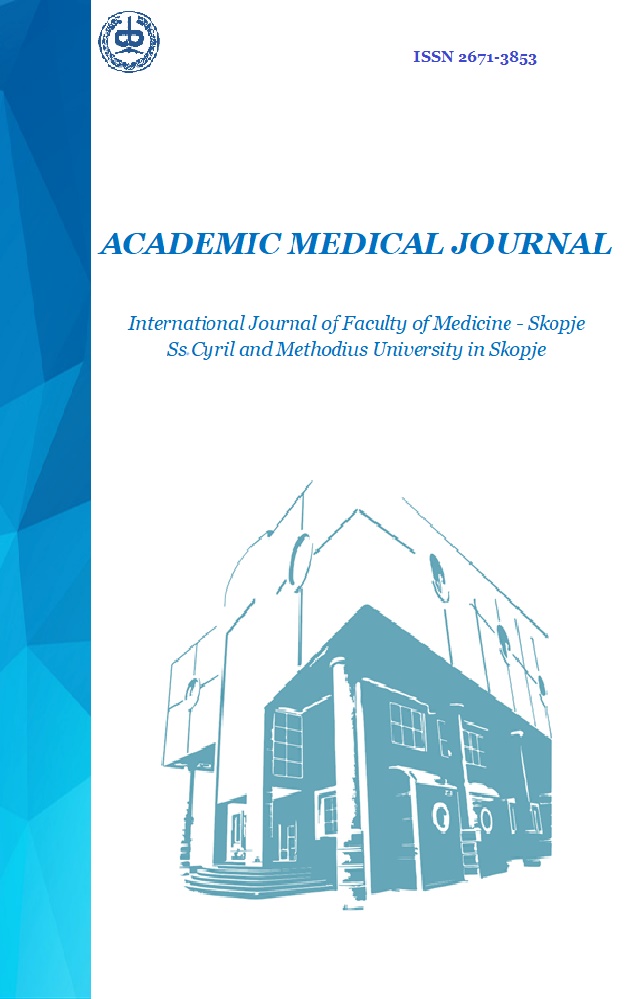BRAF MUTATION IN COLORECTAL CARCINOMA IS ASSOCIATED WITH TUMOR DEPTH, LOCATION, GRADE AND PD-L1 EXPRESSION: SINGLE CENTER EXPERIENCE
Keywords:
colorectal cancer, BRAF mutation, PDL-1Abstract
Introduction: BRAF mutations in colorectal carcinoma (CRC) are a known marker of poor prognosis and aggressive tumor behavior.
Aim: This study aimed to evaluate the correlation of BRAF mutations with tumor depth, anatomical location, histological grade, and programmed death-ligand 1 (PD-L1) expression in colorectal carcinoma.
Material and methods: A retrospective prospective analysis was conducted on 152 cases of CRC diagnosed at the Clinical Hospital Acibadem - Sistina. Tumor samples were tested for BRAF mutations and immunohistochemically stained for PD-L1 expression (clone SP263). Tumor depth and location were documented, and histological grades were determined. PD-L1 expression was assessed at cut-offs of 1-10%, 10-50%, and 50-100% of positive tumor cells.
Results: BRAF mutations were identified in 7.24% of cases, predominantly in right-sided colon tumors. Mutated cases exhibited greater tumor depth and higher histological grade (G3) compared to BRAF wild-type tumors. PD-L1 expression (50-100%) was significantly associated with BRAF-mutated tumors, particularly in advanced stages (IIIC and IVA). These tumors showed a higher likelihood of being located in the right colon and were linked to poorer differentiation and increased immune checkpoint expression.
Conclusion: BRAF mutations in CRC are associated with aggressive tumor characteristics, including greater depth, high grade, and right-sided location. The strong correlation with PD-L1 expression suggests potential therapeutic benefits of immune checkpoint inhibitors in BRAF-mutated CRC cases. Early identification of these mutations is crucial for optimizing patient outcomes.
References
Ciombor KK, Strickler JH, Bekaii-Saab TS, Yaeger R. BRAF-Mutated Advanced Colorectal Cancer: A Rapidly Changing Therapeutic Landscape. J Clin Oncol Off J Am Soc Clin Oncol 2022; 40(24): 2706–2715. doi: 10.1200/JCO.21.02541.
Li ZN, Zhao L, Yu LF, Wei MJ. BRAF and KRAS mutations in metastatic colorectal cancer: future perspectives for personalized therapy. Gastroenterol Rep 2020; 8(3): 192–205. doi: 10.1093/gastro/goaa022.
Li Y, Xiao J, Zhang T, Zheng Y, Jin H. Analysis of KRAS, NRAS, and BRAF Mutations, Microsatellite Instability, and Relevant Prognosis Effects in Patients With Early Colorectal Cancer: A Cohort Study in East Asia. Front Oncol 2022; 12: 897548. doi: 10.3389/fonc.2022.897548.
Srivastava P, Husain N, Shukla S, Chauhan S, Pandey A, Masood S. PD-L1 Expression in colorectal carcinoma and its correlation with clinicopathological parameters, microsatellite instability and BRAF mutation. Indian J Pathol Microbiol 2021; 64(3): 490–496. doi: 10.4103/IJPM.IJPM_521_20.
Rosenbaum MW, Bledsoe JR, Morales-Oyarvide V, Huynh TG, Mino-Kenudson M. PD-L1 expression in colorectal cancer is associated with microsatellite instability, BRAF mutation, medullary morphology and cytotoxic tumor-infiltrating lymphocytes. Mod Pathol 2016; 29(9): 1104–1112. doi: 10.1038/modpathol.2016.95.
James D Brierley, Mary.K Gospodarowicz, Christian Witekkind. TNM Classification of Malignant tumors. Eight edition, UICC, Wiley, 2018.
Dedieu S, Bouché O. Clinical, Pathological, and Molecular Characteristics in Colorectal Cancer. Cancers (Basel) 2022; 14(23): 5958. doi: 10.3390/cancers14235958.
Chen K, Collins G, Wang H, Toh JWT. Pathological Features and Prognostication in Colorectal Cancer. Curr Oncol 2021; 28(6): 5356-5383. doi: 10.3390/ curroncol28060447.
Crutcher M, Waldman S. Biomarkers in the development of individualized treatment regimens for colorectal cancer. Front Med (Lausanne) 2022; 9: 1062423. doi: 10.3389/fmed.2022.1062423.
Yang L, Xue R, Pan C. Prognostic and clinicopathological value of PD-L1 in colorectal cancer: a systematic review and meta-analysis. Onco Targets Ther 2019; 12: 3671-3682. doi: 10.2147/OTT.S190168.
Noh BJ, Kwak JY, Eom DW. Immune classification for the PD-L1 expression and tumour-infiltrating lymphocytes in colorectal adenocarcinoma. BMC Cancer 20, 58 (2020). https://doi.org/10.1186/s12885-020-6553-9
Zs, Ooi. RAS and BRAF Genes as Biomarkers and Target for Personalised Colorectal Cancer Therapy: An Update. Malays J Pathol, 2022.
Saxena S, Srinivas V, Deb P, Raman DK, Jagani R. A study of BRAF mutation in colorectal carcinoma in Indian population. J Cancer Res Ther 2018; 14(6): 1403-1406. doi: 10.4103/jcrt.JCRT_26_17.
Grothey A, Fakih M, Tabernero J. Management of BRAF-mutant metastatic colorectal cancer: a review of treatment options and evidence-based guidelines. Ann Oncol 2021; 32(8): 959-967. doi: 10.1016/j.annonc.2021.03.206.
Yaghoubi N, Soltani A, Ghazvini K, Hassanian SM, Hashemy SI. PD-1/ PD-L1 blockade as a novel treatment for colorectal cancer. Biomed Pharmacother 2019; 110: 312-318. doi: 10.1016/j.biopha.2018.11.105.
Shek D, Akhuba L, Carlino MS, Nagrial A, Moujaber T, Read SA, et al. Immune-Checkpoint Inhibitors for Metastatic Colorectal Cancer: A Systematic Review of Clinical Outcomes. Cancers (Basel) 2021; 13(17): 4345. doi: 10.3390/cancers13174345.
Rawla P, Barsouk A, Hadjinicolaou AV, Barsouk A. Immunotherapies and Targeted Therapies in the Treatment of Metastatic Colorectal Cancer. Med Sci (Basel) 2019; 7(8): 83. doi: 10.3390/medsci7080083.
Martini G, Dienstmann R, Ros J, Baraibar I, Cuadra-Urteaga JL, Salva F, et al. Molecular subtypes and the evolution of treatment management in metastatic colorectal cancer. Ther Adv Med Oncol 2020; 12: 1758835920936089. doi: 10.1177/1758835920936089.
Imyanitov E, Kuligina E. Molecular testing for colorectal cancer: Clinical applications. World J Gastrointest Oncol 2021; 13(10): 1288-1301. doi: 10.4251/wjgo.v13.i10.1288.
Ntomi, Vasileia, Periklis Foukas, Dimitrios Papaconstantinou, Ioanna Antonopoulou, Andreas Pikoulis, Ioannis Panagiotides, Emmanouil Pikoulis, and Konstantinos Syrigos. “The Clinical Significance of PD L1 in Colorectal Cancer (Review).” Oncology Reports 45, no. 6 (June 1, 2021): 1–9.
Li, Yan, Meizhi He, Yaoyao Zhou, Chen Yang, Shuyi Wei, Xiaohui Bian, Odong Christopher, and Lang Xie. “The Prognostic and Clinicopathological Roles of PD-L1 Expression in Colorectal Cancer: A Systematic Review and Meta-Analysis.” Frontiers in Pharmacology 10 (February 28, 2019).
Secinti, Ilke Evrim, Tumay Ozgur, and Isa Dede. “PD-L1 Expression in Colorectal Adenocarcinoma Is Associated With the Tumor Immune Microenvironment and Epithelial-Mesenchymal Transition.” American Journal of Clinical Pathology 158, no. 4 (October 1, 2022): 506–15.
Zarbakhsh, Alireza, Amirreza Khalaji, Amir Vahedi, Roya Dolatkhah, and Nasrin Gholami. “Correlation between PD-L1 Expression, Clinicopathological Factors, and Metastasis Risk in Colorectal Cancer Patients.” European Journal of Cancer Care 2024, no. 1 (2024): 5578953.
Downloads
Published
Issue
Section
License
This work is licensed under CC BY 4.0 





